Fracture Analysis and Working Stress Calculation of Bearing Cage Used in Charging Pump in a Nuclear Power Plant
Abstract
:1. Introduction
2. Investigative and Analysis Methods
2.1. Failure Investigation Process
- (1)
- Investigation of the bearing procurement channel and confirmation with SKF to ensure the authenticity of the bearing.
- (2)
- Collection of detailed information regarding the pump failure process, historical operational data, maintenance records, and experiences with similar equipment failures.
- (3)
- List and analysis of possible failure modes for the bearing failure, as depicted in Figure 2.
- (4)
- Designing protocols for metallurgical experimental studies based on the identified failure modes.
- (5)
- Perform analysis work on the fractured bearing cage sample and summarize and analyze all the obtained data.
- (6)
- Analyze the operating conditions of the bearing, establish boundary conditions, and utilize finite element calculation and analysis software to assess the forces acting on the bearing cage.
- (7)
- Explore corrective action plans aimed at preventing the recurrence of bearing failures.
2.2. Metallological Analysis Process
2.3. Calculation Condition of Working Stress of Bearing Cage
3. Results and Discussion
3.1. Fracture Morphologies Analysis of Bearing Cage
3.2. Chemical Composition Analysis of Bearing Cage
3.3. Observation of Metallographic Structure of Bearing Cage
3.4. Hardness Test of The Bearing Cage and Roller
3.5. Residual Stress Test at Stamping Position of Bearing Cage
3.6. Calculation Results of Working Stress of Bearing Cage
3.7. Discussion on Corrective Measures
4. Conclusions
- (1)
- The material of the bearing cage was carbon structural steel with the proper chemical composition, microstructure, and hardness.
- (2)
- The fracture of the bearing cage was located at the stamping depression position, which showed fatigue fracture mode.
- (3)
- The bearing cage had large residual stress at some stamping positions of up to 142 MPa. When the bearing was running, the working stress reached the maximum while the bearing roller entered and exited the working area. The direction of the residual stress was the same as that of the working stress, both of which were tensile stresses perpendicular to the fracture direction. The superposition of the two stresses exceeded the material fatigue limit.
- (4)
- The new structure could reduce the stress concentration of the steel cage, thus improving its reliability.
- (5)
- The nylon cage had the lowest stress concentration (without residual stress) and a good lubrication function, which further improved its reliability.
- (6)
- Both materials and structures should be considered simultaneously in the future design of bearing cages.
Author Contributions
Funding
Data Availability Statement
Acknowledgments
Conflicts of Interest
References
- Warda, B.; Chudzik, A. Effect of ring misalignment on the fatigue life of the radial cylindrical roller bearing. Int. J. Mech. Sci. 2016, 111–112, 1–11. [Google Scholar] [CrossRef]
- Salam, I.; Tauqir, A.; Haq, A.U.; Khan, A.Q. An air crash due to fatigue failure of a ball bearing. Eng. Fail. Anal. 1998, 5, 261–269. [Google Scholar] [CrossRef]
- Guo, H.; Duan, H.T.; Lei, J.Z.; Wang, D.F.; Du, S.M.; Zhang, Y.Z.; Ding, Z.Y. Failure analysis of automobile engine pump shaft bearing. Adv. Mech. Eng. 2021, 13, 1–9. [Google Scholar] [CrossRef]
- Oktaviana, L.; Tong, V.C.; Hong, S.W. Skidding analysis of angular contact ball bearing subjected to radial load and angular misalignment. J. Mech. Sci. Technol. 2019, 33, 837–845. [Google Scholar] [CrossRef]
- Yang, Z.C.; Zhang, Y.; Zhang, K.; Li, S.H. Wear analysis of angular contact ball bearing in multiple-bearing spindle system subjected to uncertain initial angular misalignment. J. Tribol. 2021, 143, 091703. [Google Scholar] [CrossRef]
- Huang, H.J.; Wang, X.; Xue, K.J. Effect of Cage Wear in Rolling Bearing on Bearing Failure. Lubr. Eng. 2021, 46, 128–136. [Google Scholar]
- Yang, Z.H.; Niu, X.L.; Li, C.H. Experimental Study on Cage Dynamic Behavior of Long-Life High-Precision Ball Bearing with Trajectory Deviation. IEEE Trans. Instrum. Meas. 2022, 71, 5011511. [Google Scholar] [CrossRef]
- Harris, T.A.; Kotzalas, M.N. Advanced Concepts of Bearing Technology: Rolling Bearing Analysis, 5th ed.; Taylor & Francis Group: Boca Raton, FL, USA, 2006. [Google Scholar]
- Crawford, T.S. The experimental determination of ball bearing cage stress. Wear 1970, 16, 43–52. [Google Scholar] [CrossRef]
- Liu, L.; Huo, S.; Zheng, K.; Wang, L.Q. Analysis of roller bearing cage broken under high DN value. J. Aerosp. Power 2020, 35, 2115–2122. [Google Scholar]
- Wang, P.F.; Yang, Y.; Ma, H.; Xu, H.Y.; Li, X.; Luo, Z.; Wen, B.C. Vibration characteristics of rotor-bearing system with angular misalignment and cage fracture: Simulation and experiment. Mech. Syst. Signal Process. 2023, 182, 109545. [Google Scholar] [CrossRef]
- Hinton, W.R. An investigation into the causes of ball bearing failures in types P2 and P3 engine-driven generators. Wear 1970, 16, 3–42. [Google Scholar] [CrossRef]
- Tauqir, A.; Salam, I.; Haq, A.U.; Khan, A.Q. Causes of fatigue failure in the main bearing of an aero-engine. Eng. Fail. Anal. 2000, 7, 127–144. [Google Scholar] [CrossRef]
- Wang, P.F.; Xu, H.Y.; Ma, H.; Han, H.Z.; Yang, Y. Effects of three types of bearing misalignments on dynamic characteristics of planetary gear set-rotor system. Mech. Syst. Signal Process. 2022, 169, 108736. [Google Scholar] [CrossRef]
- Wei, M.; Dyson, J.E.; Darvell, B.W. Failure analysis of the ball bearings of dental air turbine hand pieces. Aust. Dent. J. 2013, 58, 514–521. [Google Scholar] [CrossRef] [PubMed]
- Sakaguchi, T. Dynamic Analysis for Needle Roller Bearings Under Planetary Motion. NTN Tech. Rev. 2007, 75, 94–100. [Google Scholar]
- Nogi, T.; Maniwa, K.; Matsuoka, N. A dynamic analysis of cage instability in ball bearings. J. Tribo. 2018, 140, 88–96. [Google Scholar] [CrossRef]
- Deng, S.E.; Xie, P.F.; Yang, H.S.; Gao, Y.T. Flexible-body dynamics analysis on cage of high-speed angular contact ball bearing. Acta Armamentarii 2011, 32, 626–631. [Google Scholar]
- Feng, Y.J.; Yin, Y.F.; Zhao, C.J.; Zhang, J. Finite element analysis on dynamic characteristics of angular contact ball bearing cages. Bearing 2020, 6, 1–6. [Google Scholar]
- Brooks, J.; Canfield, R.A. Slotted Waveguide Stress Concentration Factor. AIAA J. 2022, 60, 3844–3851. [Google Scholar] [CrossRef]
- Sun, L.; Huang, X.P.; Huang, Y.C.; Wu, X.Y.; Wang, F. Experimental study on fatigue crack propagation in balcony opening corners of a cruise ship. Ocean Eng. 2022, 260, 112039. [Google Scholar] [CrossRef]
- Hou, X.; Diao, Q.; Liu, Y.; Liu, C.; Zhang, Z.; Tao, C. Failure Analysis of a Cylindrical Roller Bearing Caused by Excessive Tightening Axial Force. Machines 2022, 10, 322. [Google Scholar] [CrossRef]
- Zhu, C.F.; He, J.F.; Peng, J.F.; Ren, Y.P.; Liu, X.Z.; Zhu, M.H. Failure mechanism analysis on railway wheel shaft of power locomotive. Eng. Fail. Anal. 2019, 104, 25–38. [Google Scholar] [CrossRef]
- Fan, K.F.; Liu, D.X.; Zhang, X.H.; Liu, D.; Zhao, W.D.; Yang, J.; Ma, A.; Li, M.; Qi, Y.; Xiang, J.F.; et al. Effect of residual stress induced by ultrasonic surface rolling on fretting fatigue behaviors of Ti-6Al-4V alloy. Eng. Frac. Mech. 2022, 259, 108150. [Google Scholar] [CrossRef]
- DIN EN 10111: 2008; Continuously Hot Rolled Low Carbon Steel Sheet and Strip for Cold Forming—Technical Delivery Conditions. English Version; German Institute for Standardization: Berlin, Germany, 2008.
- Hou, X.Q.; Liu, Y.J.; Li, T.Y.; Liu, C.K.; Zhang, Z.; Tao, C.H. Root Cause Failure Analysis of Deep-Groove Ball Bearing Used in a Governor. Appl. Sci. 2022, 12, 9658. [Google Scholar] [CrossRef]
- Schlicht, H.; Vetters, H. Residual stresses in roller bearing components. Mater. Sci. Forum 2013, 768–769, 755–761. [Google Scholar] [CrossRef]
- Wang, H.; Wanchuck Woob, W.; Lee, S.Y.; An, G.; Kim, D.K. Correlation of localized residual stresses with ductile fracture toughness using in situ neutron diffraction and finite element modelling. Int. J. Mech. Sci. 2019, 160, 332–342. [Google Scholar] [CrossRef]
- Huang, Y.T.; Hung, F.Y.; Yen, C.W. Microstructure and fracture toughness of hot-rolling biomedical degradable ZKX500 magnesium bone plates. Micron 2023, 172, 103500. [Google Scholar] [CrossRef]
- Shoemaker, T.K.; Harris, Z.D.; Smudde, C.M.; Hill, M.R.; Burns, J.T. 3D fatigue crack path deflection and residual stresses in 17-4PH stainless steel rod. Int. J. Frac. 2023, 175, 107735. [Google Scholar] [CrossRef]
- Nguyen, T.T.; Pham, V.; Tran, H.A.; Nguyen, D.H.; Nguyen, T.H.; Dinh, H.B. Effect of Residual Stress on Mode-I Stress Intensity Factor: A Quantitative Evaluation and a Suggestion of an Estimating Equation. Metals 2023, 13, 1132. [Google Scholar] [CrossRef]
- Song, W.; Man, Z.; Xu, J.; Wang, X.X.; Liu, C.Q.; Zhou, G.T.; Berto, F. Fatigue Crack Growth Behavior of Different Zones in an Overmatched Welded Joint Made with D32 Marine Structural Steel. Metals 2023, 13, 535. [Google Scholar] [CrossRef]
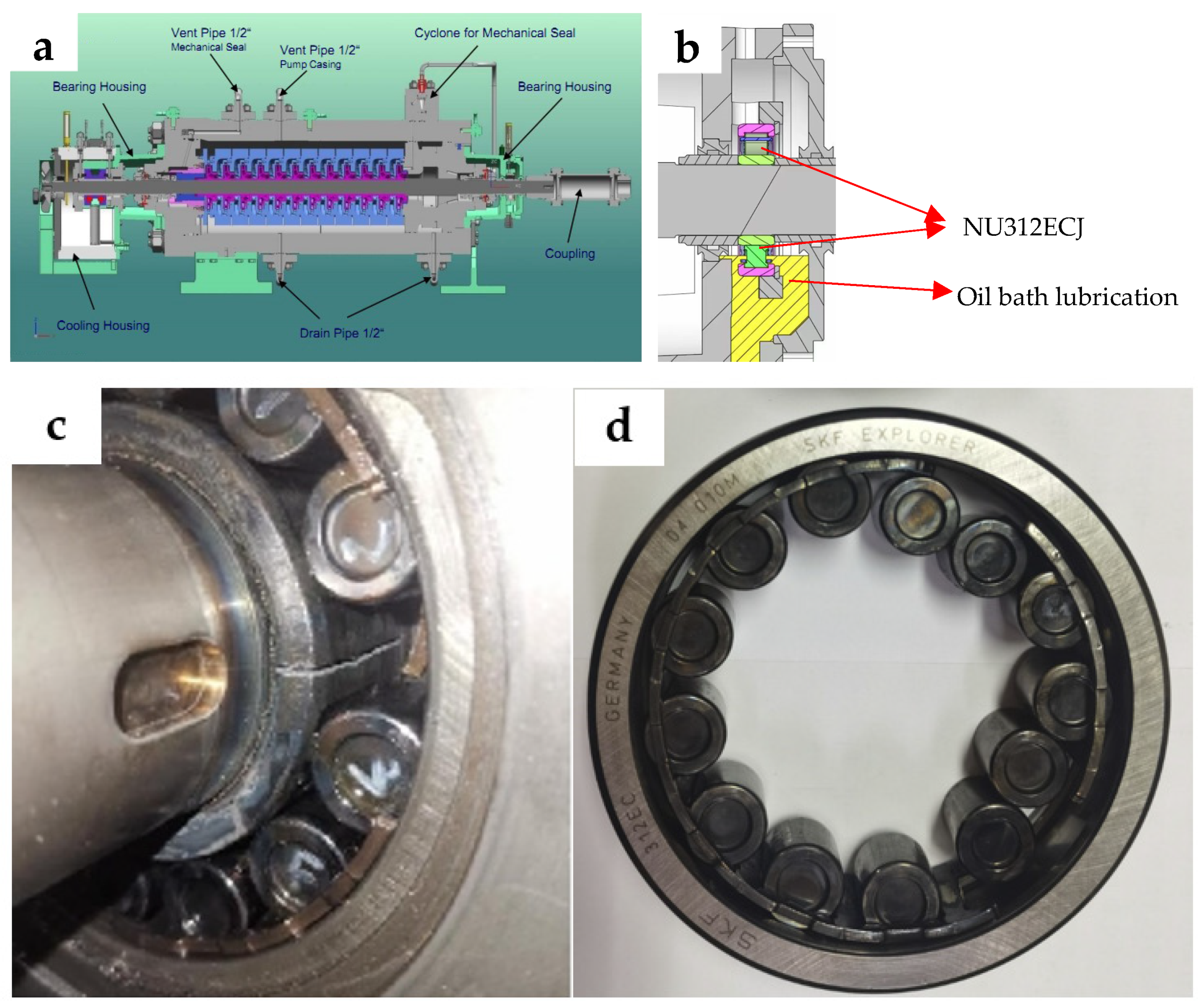
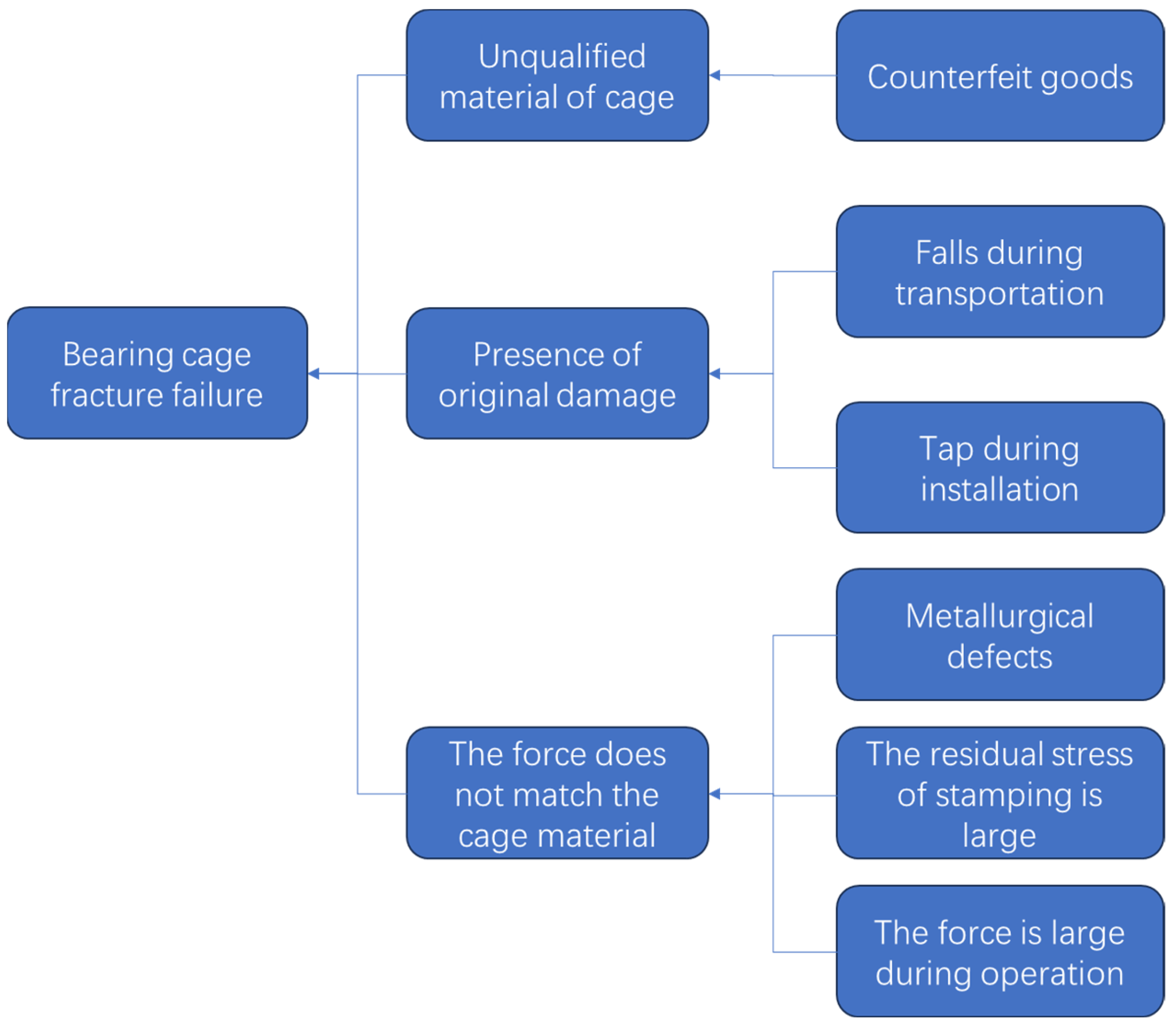

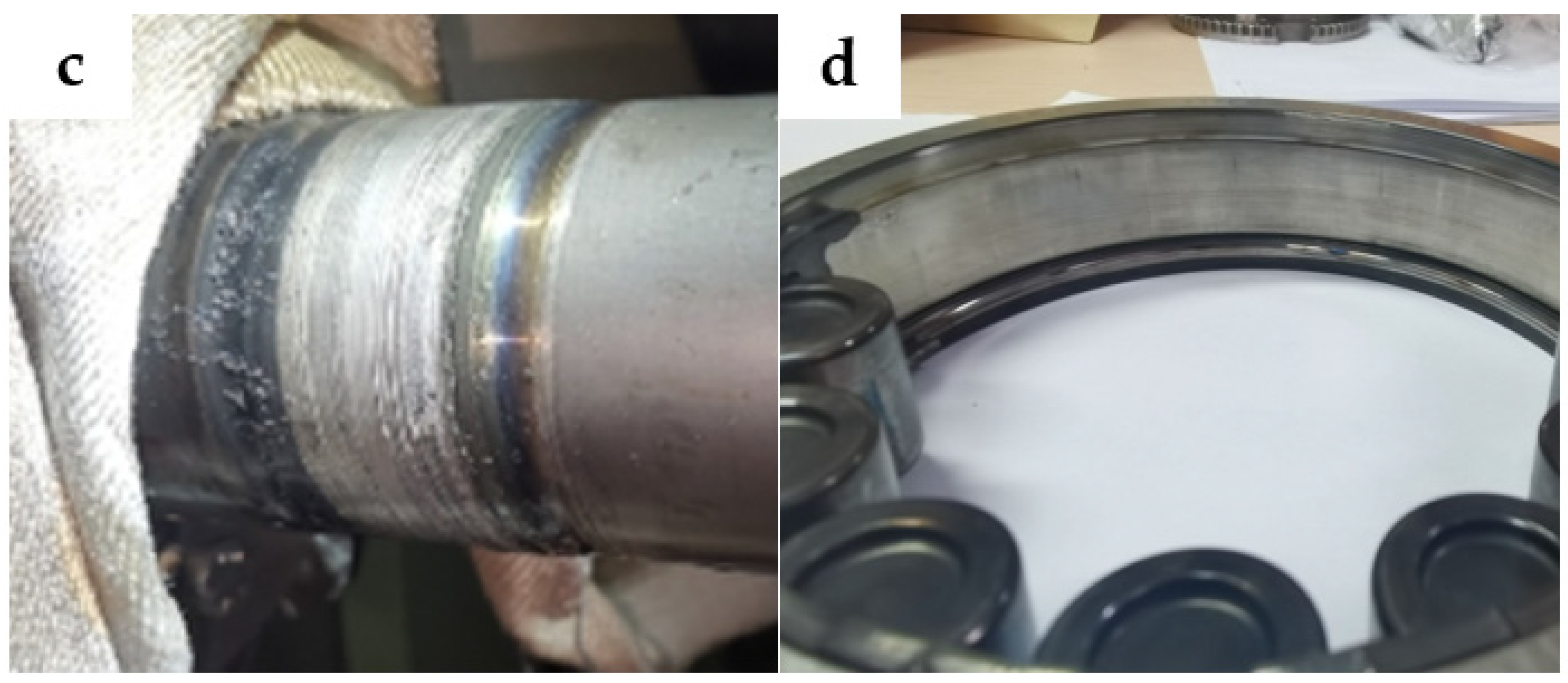
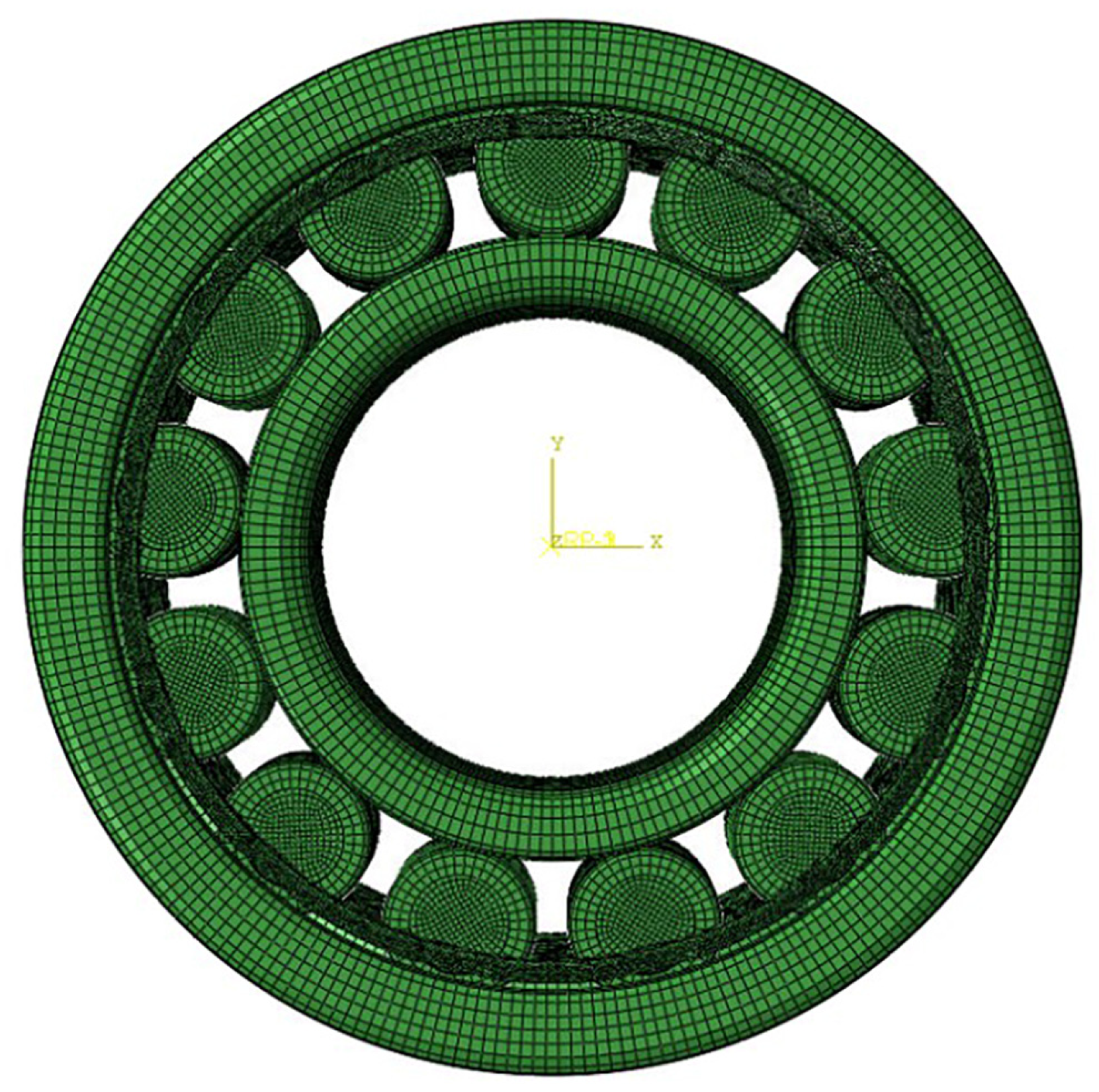
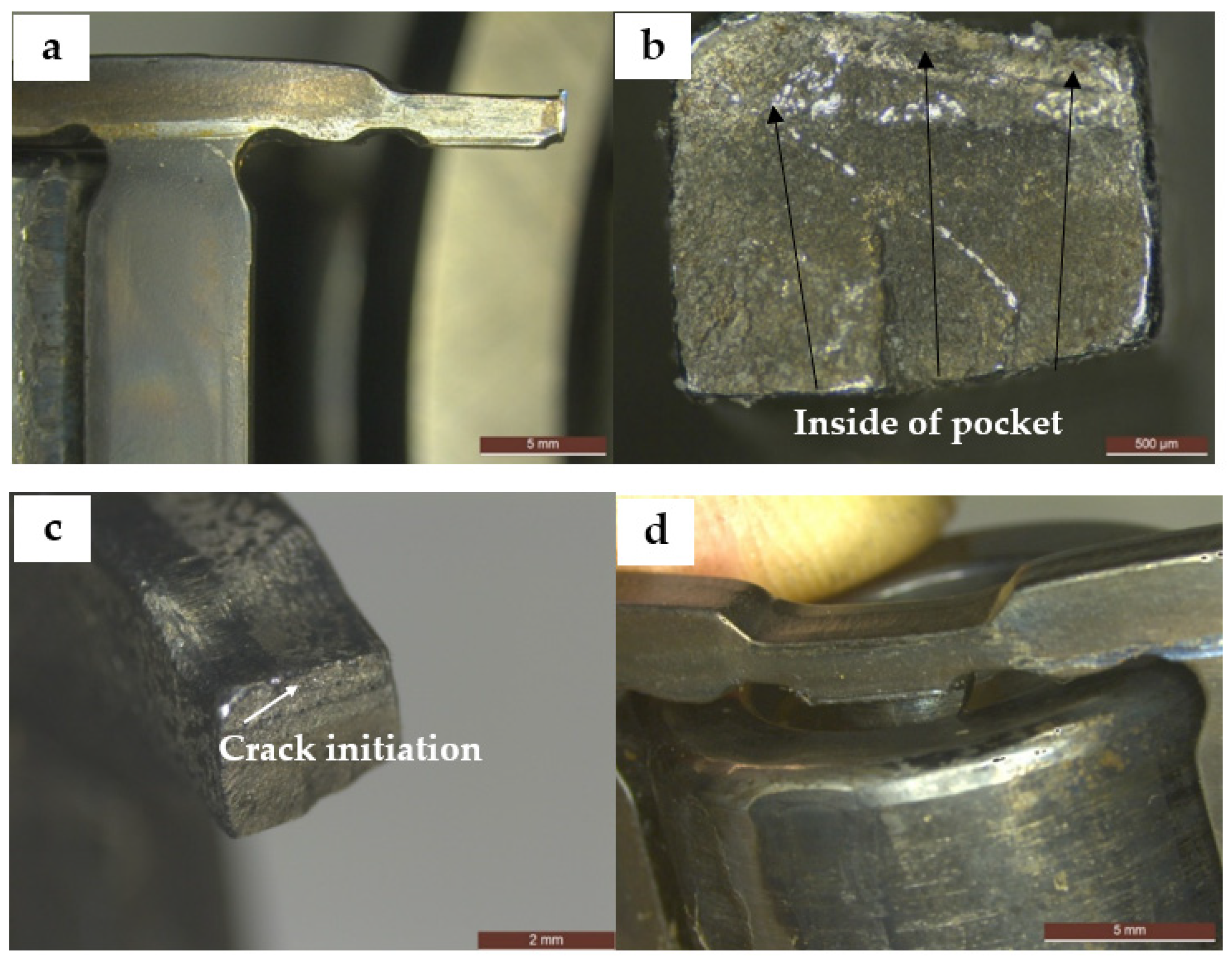
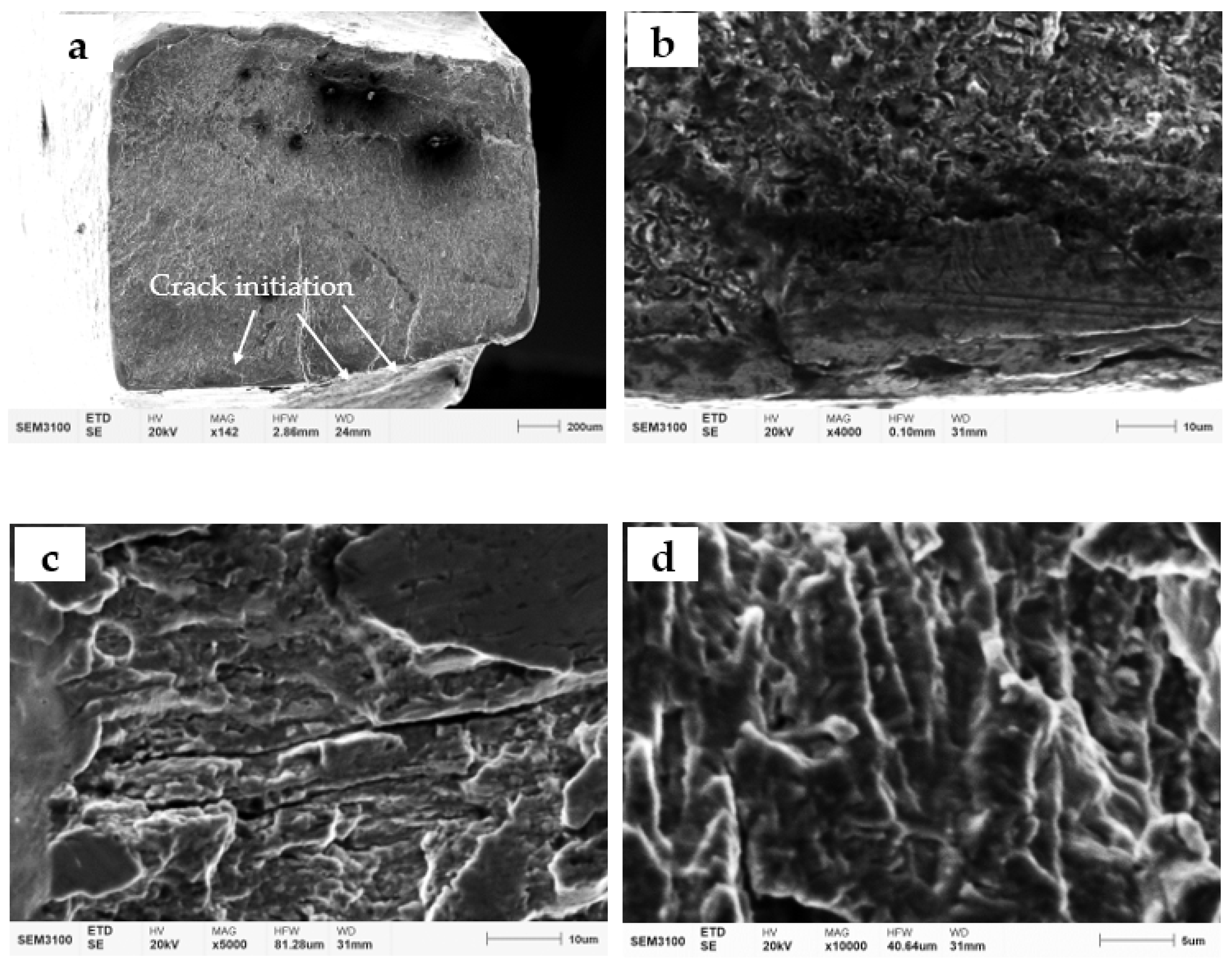
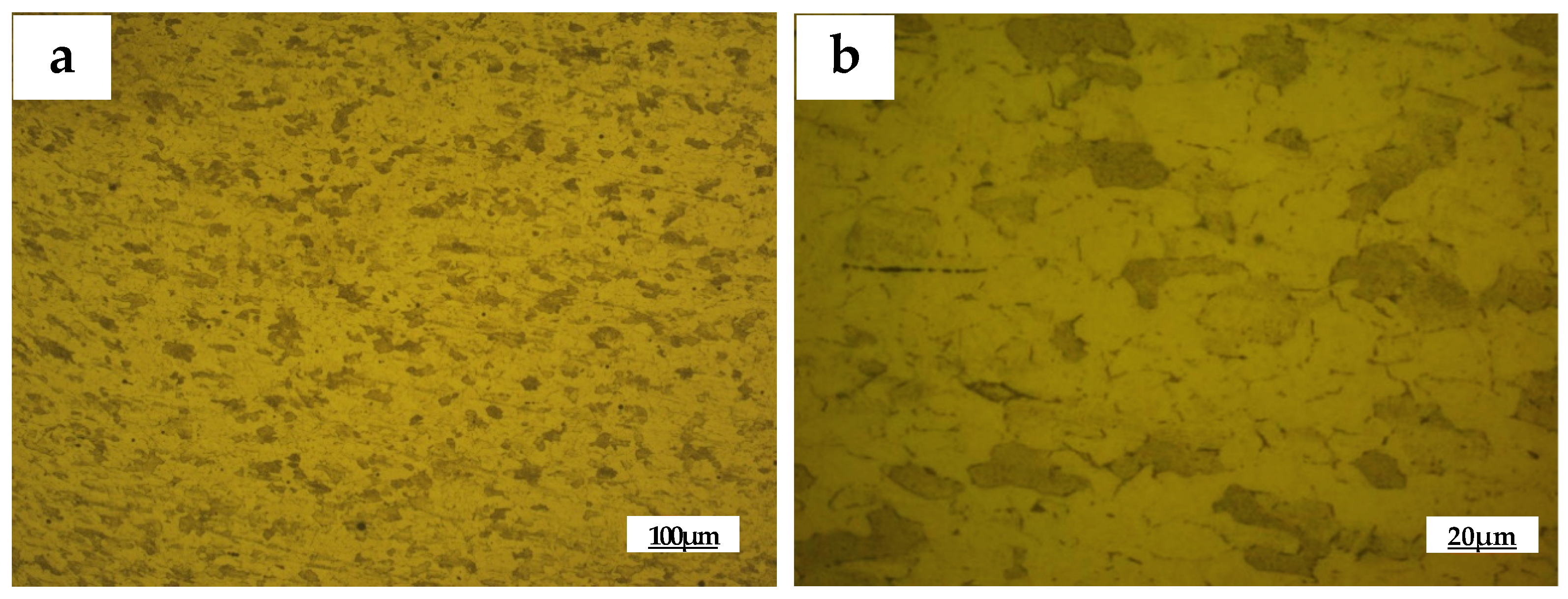
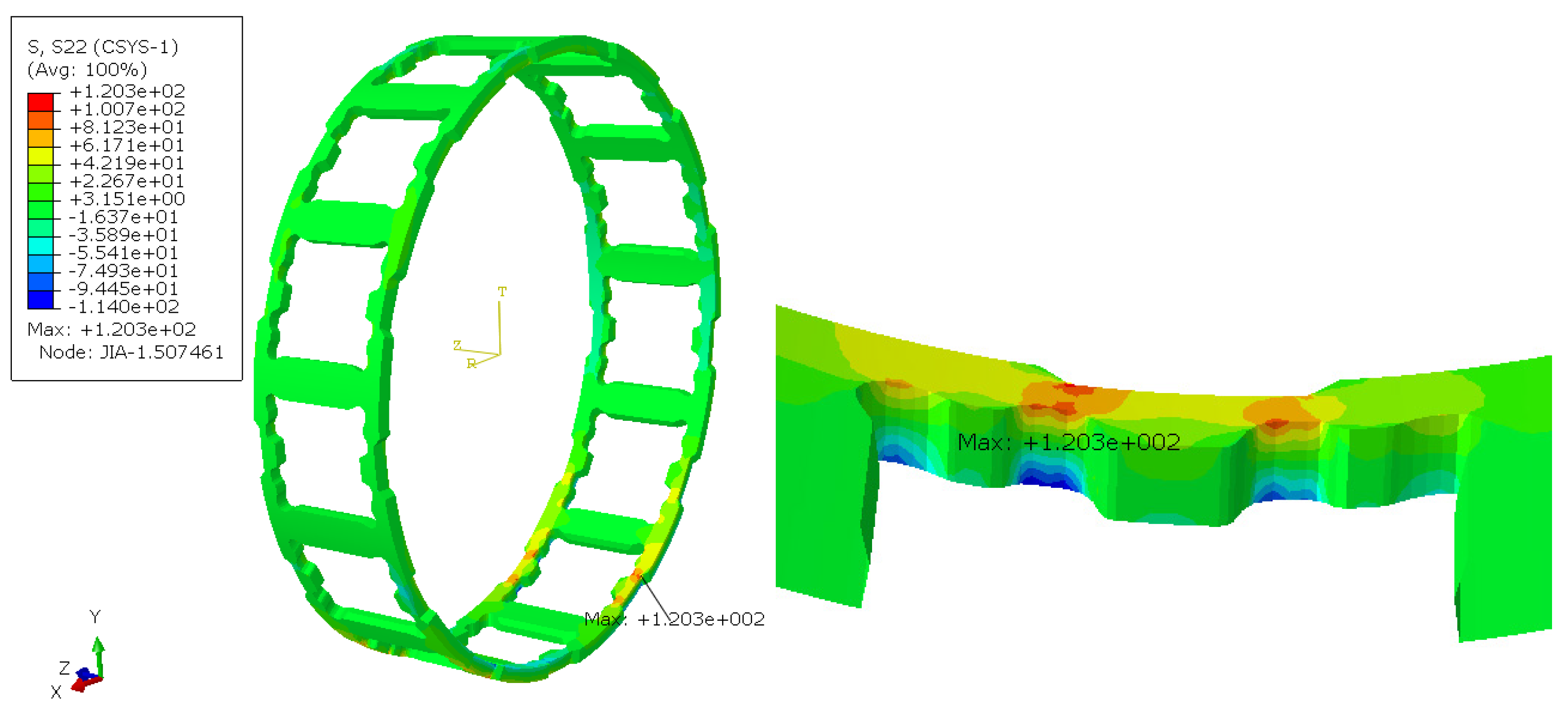
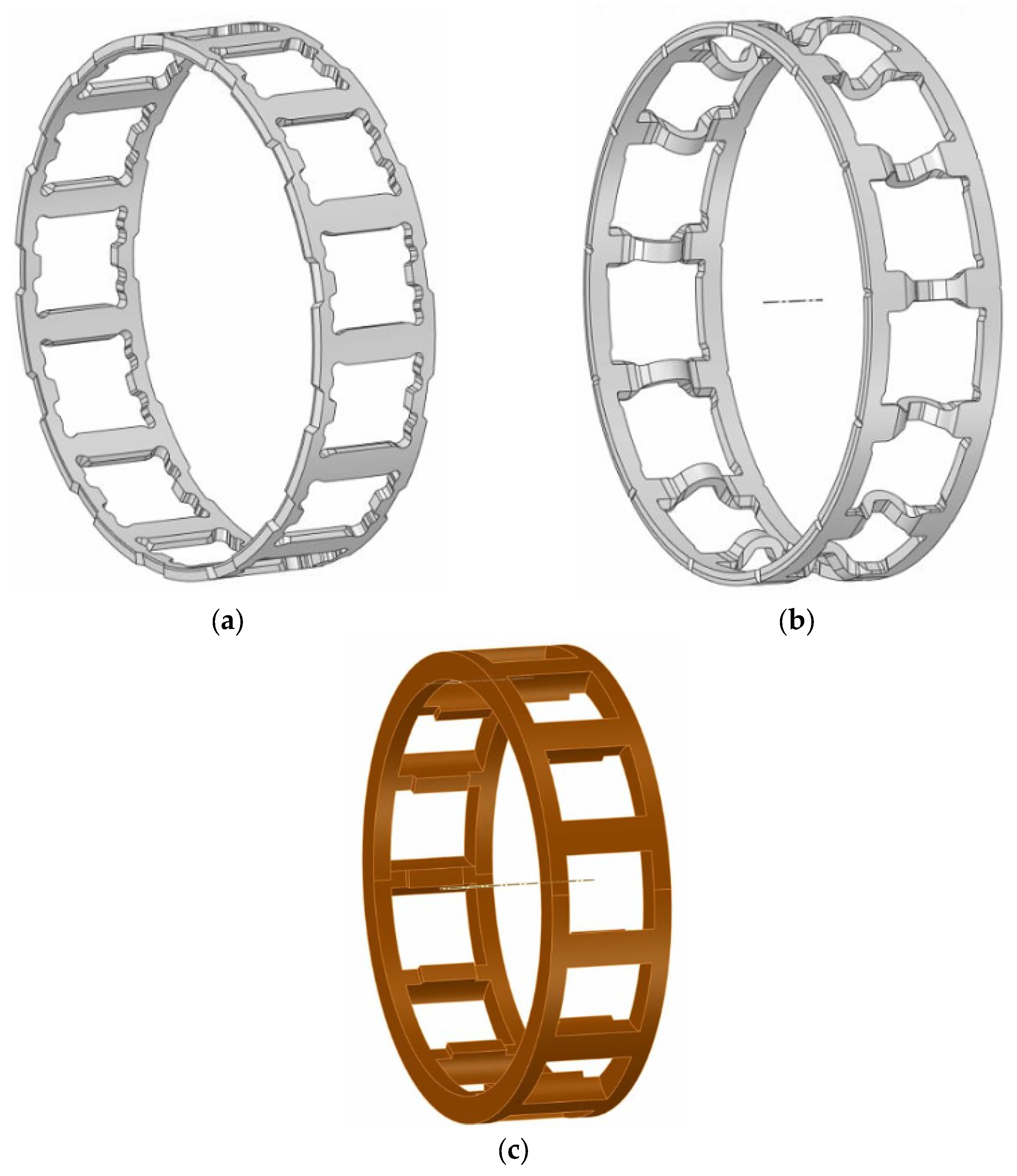
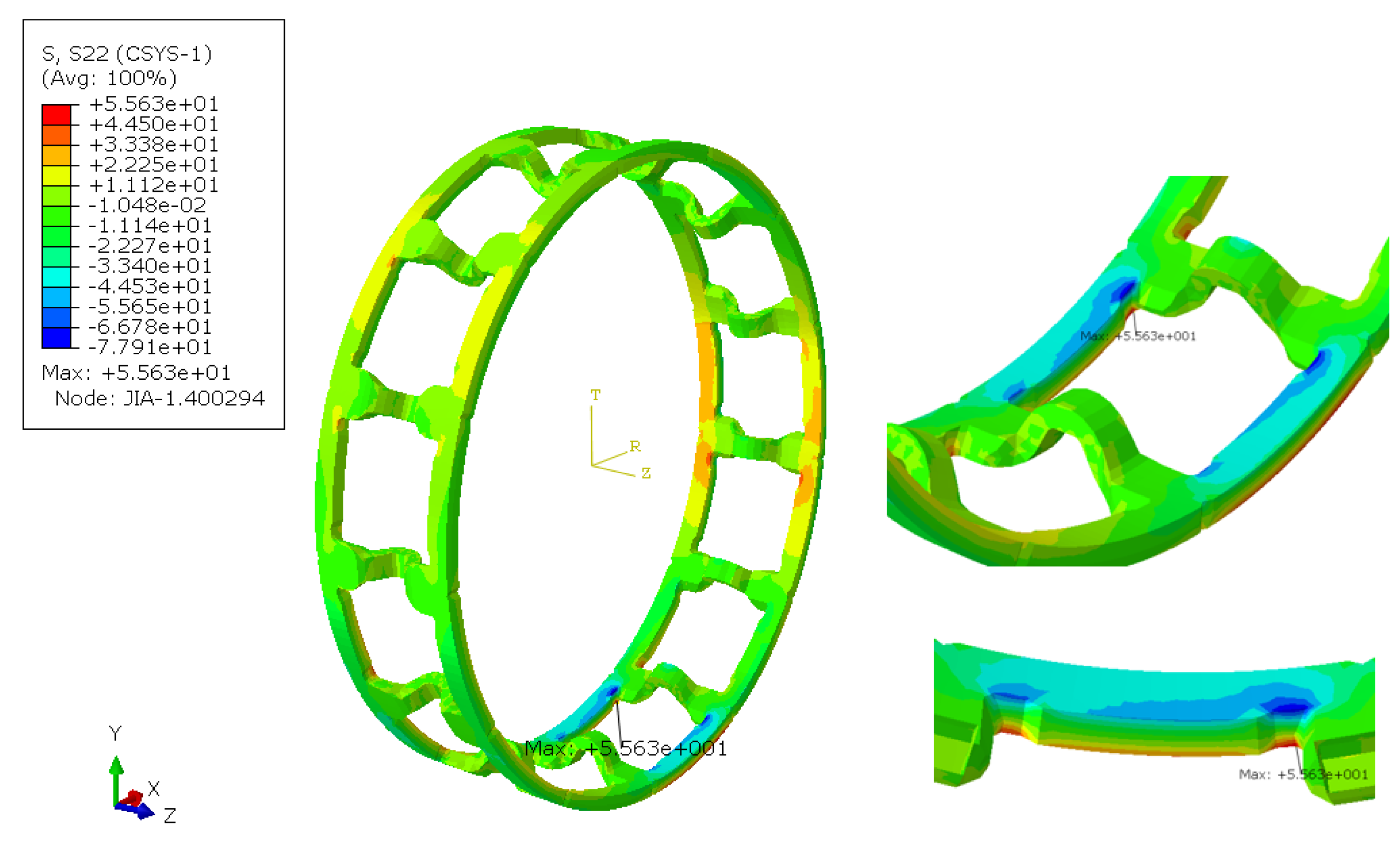
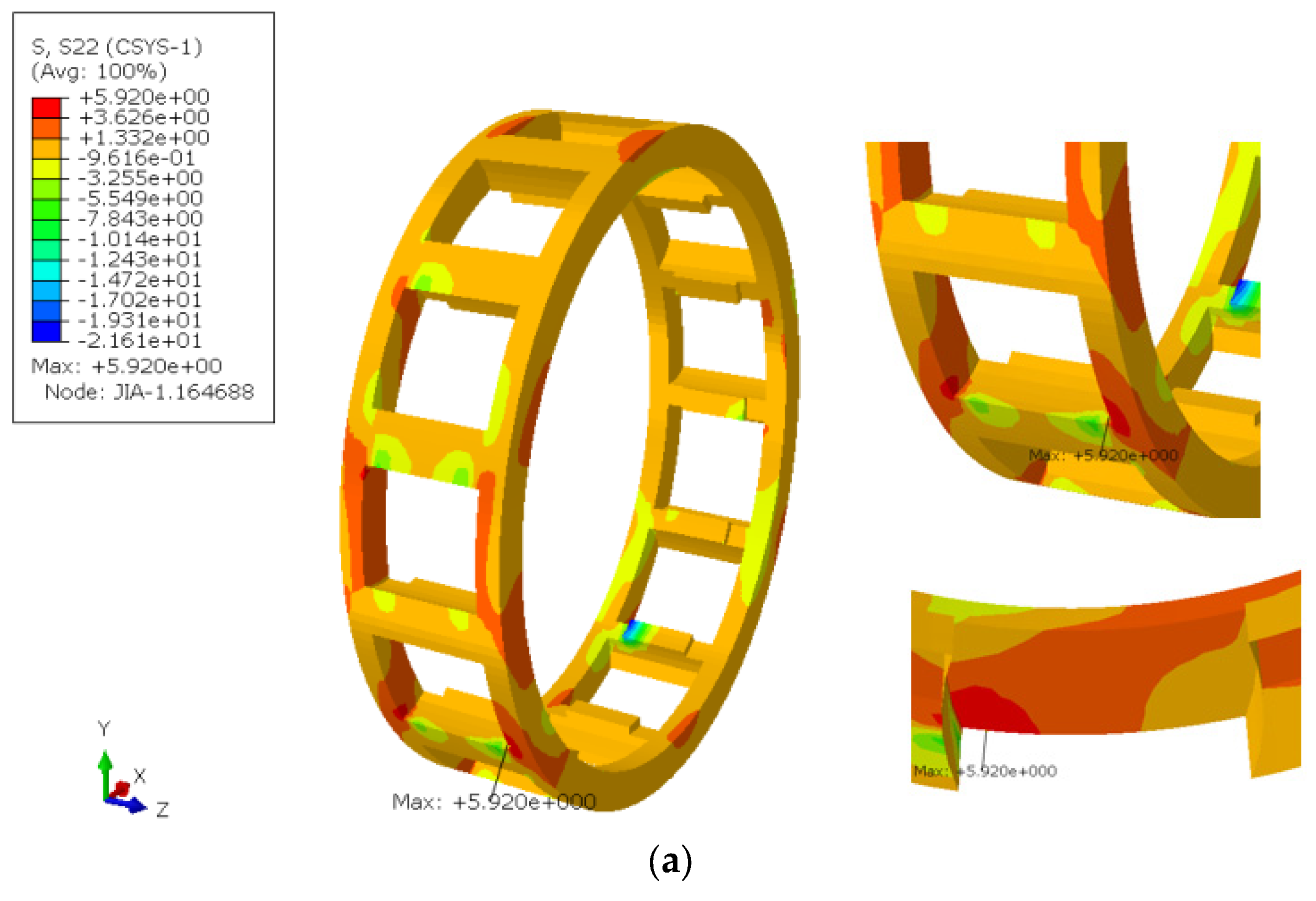
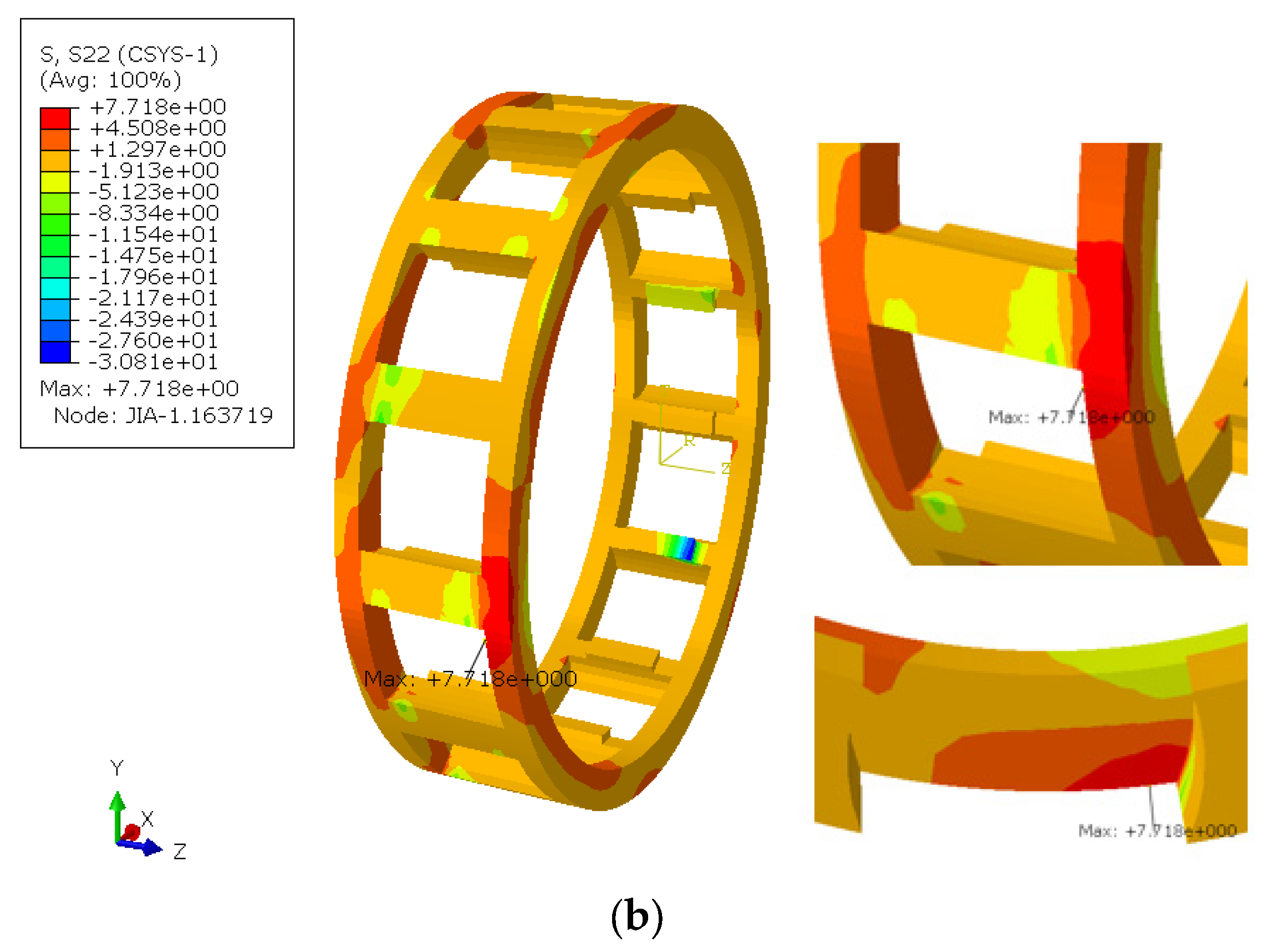
| Load | Speed | Friction Coefficient | ||
|---|---|---|---|---|
| Between Roller and Inner and Outer Rings | Between Roller and Outer Ring Edge | Between Roller and Cage | ||
| 725 N | 4657 r/min | 0.02 | 0.05 | 0.1 |
| Subject | C | Mn | Si | Cr | Ni | Cu | P | S | Fe | |
|---|---|---|---|---|---|---|---|---|---|---|
| Sample | 0.044 | 0.22 | <0.03 | <0.03 | <0.03 | <0.03 | 0.010 | <0.001 | Bal. | |
| DIN EN 10111: 2008 | DD11 | ≤0.12 | ≤0.6 | - | - | - | - | ≤0.045 | ≤0.045 | Bal. |
| DD12 | ≤0.1 | ≤0.45 | - | - | - | - | ≤0.035 | ≤0.035 | Bal. | |
| DD13 | ≤0.08 | ≤0.4 | - | - | - | - | ≤0.030 | ≤0.030 | Bal. | |
| DD14 | ≤0.08 | ≤0.35 | - | - | - | - | ≤0.025 | ≤0.025 | Bal. | |
| Sample | 1 | 2 | 3 | 4 | Average |
|---|---|---|---|---|---|
| Roller | 481 | 469 | 479 | 483 | 478 |
| Cage | 160 | 168 | 164 | 164 | 164 |
| Sample | 1 | 2 | 3 | 4 | Average |
|---|---|---|---|---|---|
| Cage | 53 | 7 | 142 | 60 | 66 |
| No. | Load | Speed | Friction Coefficient | ||
|---|---|---|---|---|---|
| Between Roller and Inner and Outer Rings | Between Roller and Outer Ring Edge | Between Roller and Cage | |||
| 1 | 725 N | 4657 r/min | 0.02 | 0.05 | 0.1 |
| 2 | 0.05 | 0.08 | 0.12 | ||
Disclaimer/Publisher’s Note: The statements, opinions and data contained in all publications are solely those of the individual author(s) and contributor(s) and not of MDPI and/or the editor(s). MDPI and/or the editor(s) disclaim responsibility for any injury to people or property resulting from any ideas, methods, instructions or products referred to in the content. |
© 2023 by the authors. Licensee MDPI, Basel, Switzerland. This article is an open access article distributed under the terms and conditions of the Creative Commons Attribution (CC BY) license (https://creativecommons.org/licenses/by/4.0/).
Share and Cite
Chen, Q.; Jiang, S.; Duan, D. Fracture Analysis and Working Stress Calculation of Bearing Cage Used in Charging Pump in a Nuclear Power Plant. Metals 2023, 13, 1380. https://doi.org/10.3390/met13081380
Chen Q, Jiang S, Duan D. Fracture Analysis and Working Stress Calculation of Bearing Cage Used in Charging Pump in a Nuclear Power Plant. Metals. 2023; 13(8):1380. https://doi.org/10.3390/met13081380
Chicago/Turabian StyleChen, Qiang, Shengli Jiang, and Deli Duan. 2023. "Fracture Analysis and Working Stress Calculation of Bearing Cage Used in Charging Pump in a Nuclear Power Plant" Metals 13, no. 8: 1380. https://doi.org/10.3390/met13081380
APA StyleChen, Q., Jiang, S., & Duan, D. (2023). Fracture Analysis and Working Stress Calculation of Bearing Cage Used in Charging Pump in a Nuclear Power Plant. Metals, 13(8), 1380. https://doi.org/10.3390/met13081380






